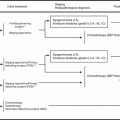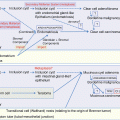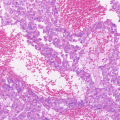Author
Year
Number of patients
Positive rate(%)
Stage (%)
Positive rate(%)
la
lb
lc
PEN
PAN
Sakuragi, et al
2000
78
5.1
3.2
–
6.4
0
5.1
Suzuki, et al
2000
47
10.6
5.6
–
13.8
8.5
4.3
Cass, et al
2001
96
14.5
–
–
–
9.4
7.3
Takeshima, et al
2001
156
12.8
9.3
33.3
15.4
7.1
9.6
Harter, et al
2007
48
6.2
0
25.0
8.0
–
–
Fournier, et al
2009
54
9.3
3.8
0
17.4
–
–
Nomura, et al
2010
60
13.3
28.6
0
9.1
8.3
11.7
Mikami, et al
2014
89
12.3
4
50
17.6
10.1
6.7
Accordingly, surgical treatment of ovarian cancer, including systematic lymphadenectomy, should only be performed at institutions that specialize in gynecologic oncology, in order to ensure accurate staging of the tumor.
11.8 Lymphadenectomy for Advanced Ovarian Cancer: Complete Dissection Versus Resection of Bulky Nodes
Primary debulking surgery has been an integral part of treating advanced ovarian cancer. However, it is still unclear whether systematic resection of the retroperitoneal lymph nodes should be part of maximal debulking surgery, and the therapeutic value of systematic lymphadenectomy for women with advanced ovarian cancer remains controversial. Retrospective studies [18] have suggested that systematic lymphadenectomy significantly improves survival in patients undergoing debulking surgery for advanced disease, but no prospective studies have been reported. Panici et al. [19] performed a multicenter randomized clinical trial that revealed significant improvement of progression-free survival by systematic lymphadenectomy, although overall survival was similar between patients receiving systematic lymphadenectomy and those undergoing resection of bulky nodes. They also reported a higher rate of lymph node metastasis in the patients receiving systematic lymphadenectomy than in those having resection of bulky nodes and confirmed that lymph node metastasis is a significant prognostic factor for survival. Furthermore, du Bois [20] reviewed three prospective randomized trials of platinum/taxane-based chemotherapy for advanced ovarian cancer and concluded that lymphadenectomy might mainly benefit patients with advanced disease who underwent complete intraperitoneal debulking. However, this conclusion needs to be confirmed by performing a further prospective randomized trial. In these three trials, 24.8% of patients who underwent pelvic and para-aortic lymphadenectomy without suspected intraoperative lymph node involvement had histologically positive nodes, whereas the rate was 17.1% in patients who underwent partial retroperitoneal lymphadenectomy. This suggests that almost one third of positive nodes are not detectable clinically and may also be missed by partial lymphadenectomy. A prospective randomized trial comparing complete intraperitoneal tumor resection with or without sampling of suspicious lymph nodes in patients with advanced ovarian cancer (Lymphadenectomy In Ovarian Neoplasms [Lion] trial) is underway, and the results will hopefully shed new light on this important issue. Accordingly, systemic pelvic and para-aortic lymphadenectomy should be considered in patients who are fit to receive optimal debulking surgery.
11.9 Can Interval Debulking Surgery (IDS) Be Recommended After Primary Debulking Surgery (PDS) with a Suboptimal Outcome?
The usefulness of interval debulking surgery (IDS) during chemotherapy has been investigated for patients in whom the maximum residual tumor diameter could not be decreased to ≤1 cm by suboptimal primary surgery. Conflicting results have been obtained, with improvement of the prognosis in one study [21] and no benefit in another study [22], so there is no consensus as to whether IDS is useful for improving the prognosis of these patients. Study European Organization for Research and Treatment of Cancer-Gyne Cancer Group (EORTC-GCG) [21] enrolled 425 patients with Stage IIb-IV advanced ovarian cancer in whom the maximum tumor diameter was ≥1 cm at primary surgery, and tumor reduction (complete or partial response) was achieved in 319 patients by 3 cycles of combination chemotherapy with cyclophosphamide + cisplatin. These 319 patients were subjected to randomized comparison of the influence of IDS on the prognosis, revealing that overall survival was 33% higher in the IDS group compared with the non-IDS group. In Study GOG152 [22], the usefulness of IDS was assessed in 550 Stage III-IV ovarian cancer patients with suboptimal primary debulking surgery. A total of 448 patients received 3 cycles of post-PDS chemotherapy with paclitaxel + cisplatin and were randomized to two groups that were treated by chemotherapy alone or IDS followed by chemotherapy. As a result, both progression-free survival and overall survival showed no significant difference between the two groups. These two randomized comparative trials yielded different results, presumably because there was a higher percentage of Stage IV patients and the residual tumor diameter was larger after primary surgery in Study EORTC-GCG, while a higher percentage of patients received PDS from gynecologic oncologists, and the residual tumor diameter was smaller in the Gynecologic Oncology Group (GOG) study. In other words, it seems likely that IDS is more closely related to improvement of the prognosis in patients with a larger residual tumor diameter after primary surgery.
11.10 Optimal Management for Preservation of Fertility
There are histopathological and clinical requirements to consider with regard to preserving fertility in patients with ovarian cancer. Histopathologically, preserving fertility is indicated for patients with Stage Ia Grade 1 or 2 serous carcinoma, mucinous carcinoma, or endometrioid carcinoma (non-clear), while it can be considered for non-clear Stage Ic (localized to one ovary with negative in ascites cytology) Grade 1 or 2 or Stage Ia clear cell carcinoma.
After fertility-preserving surgery, the recurrence rate of ovarian cancer was 5.2%, 20%, and ≥50% for Stage Ia patients with Grade 1, 2, and 3 disease, respectively, while it was 8%, 21%, and 33% for Stage Ic patients with the respective grades. These results are considered to confirm the above histopathological conditions for preserving fertility [23, 24]. However, fertility preservation should be selected with great care, because investigation of 29 Stage Ic patients revealed that the recurrence rate was higher in patients with positive ascites cytology or patients with infiltration into the capsule [25]. Because it is impossible for rapid intraoperative histopathological examination to evaluate all of the necessary factors, including the histologic type and differentiation, it is necessary to await the results of accurate postoperative histopathological diagnosis.
Importance must also be attached to the following clinical factors. (1) The patient has a strong desire for pregnancy and is of childbearing age. (2) The patient and her family fully understand the nature of ovarian cancer and fertility-preserving surgery, as well as the risk of recurrence. (3) The patient agrees to receive strict long-term follow-up after surgery. (4) The patient can undergo careful intraperitoneal exploration by a skillful gynecologic oncologist. Prior to surgery, it must also be explained fully that preservation of fertility might be impossible and reoperation (2-stage surgery) might be needed, depending on the results of postoperative histopathological examination. Because recurrence even 10 years postoperatively has been reported, it is also necessary to discuss possible completion of surgery after delivery [26].
For fertility-preserving surgery, the basic procedure includes ipsilateral salpingo-oophorectomy and omentectomy. Endometrial curettage must also be considered to exclude concurrent endometrial cancer [27, 28]. Accurate staging is required when selecting patients who can be considered for fertility-preserving surgery. Omission of any of the procedures in staging laparotomy can only be considered when very careful macroscopic observation and palpation reveal nothing abnormal. Microscopic metastasis to the contralateral ovary has been reported to be rare in patients with Grade 1 ovarian cancer in whom macroscopic observation reveals no infiltration of the capsule surface, capsule disruption, or peritoneal dissemination. To avoid infertility due to decreased ovarian reserve and postoperative adhesions, it is permissible to omit biopsy of a macroscopically normal contralateral ovary. Concerning retroperitoneal lymph node dissection, it has been reported that the frequency of metastasis is low if the patient has mucinous carcinoma or endometrioid carcinoma and if there is no intrapelvic invasion or peritoneal dissemination [27]. Because fertility may be disturbed by postoperative adhesions due to lymph node dissection, it is permissible to limit examination to biopsy or lower levels if the clinical probability of metastasis is low.
Since the prognosis of the disease after recurrence is generally poor [29], very careful attention to management and providing adequate information for patients are essential.
11.11 Surgery for Elderly Patients
It is thought that maximal debulking surgery should also be performed in elderly patients with the aim of achieving complete resection, although the age range corresponding to “elderly” is not well defined. It is important to plan surgery by taking the patient’s general condition, nutritional status, and complications into consideration. Caution must be exercised when performing surgical treatment on elderly patients because the incidence of intraoperative complications is higher and perioperative complications are also more frequent due to cardiac dysfunction [30]. The 30-day mortality rate after ovarian cancer surgery gradually increases with age from <70 years old to 70–79 years and then >80 years, with the causes of death including postoperative infection, hemorrhage, respiratory failure, heart failure, and thromboembolism. The incidence of perioperative complications increases as surgery becomes more complex due to addition of partial bowel resection, diaphragmatic resection, and/or splenectomy to the standard procedure of bilateral salpingo-oophorectomy + total hysterectomy + omentectomy. The best surgical procedure should be selected by considering the patient’s age, general condition, nutritional status, and tumor stage at the time of diagnosis. The general condition is evaluated by determining the performance status (PS) (Table 11.2) and by using the American Society of Anesthesiologists (ASA) physical status classification (Table 11.3). Special care must be taken when the general condition corresponds to ASA Class 3 or higher (equivalent to a PS of 3 or higher) and the nutritional status is poor (serum albumin <3.0 g/dL), as well as when surgery is performed for Stage III or IV cancer [30]. In these patients, NAC should be performed before surgery is considered. After improvement of the general condition and the nutritional status, complete surgery can be performed as IDS [31]. However, performing NAC also requires care in the elderly because of the risk of complications such as thrombosis.
Table 11.2




ECOG performance status. Reuse from http://ecog-acrin.org/resources/ecog-performance-status, with permission
Stay updated, free articles. Join our Telegram channel

Full access? Get Clinical Tree







